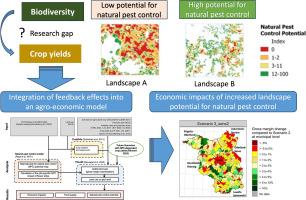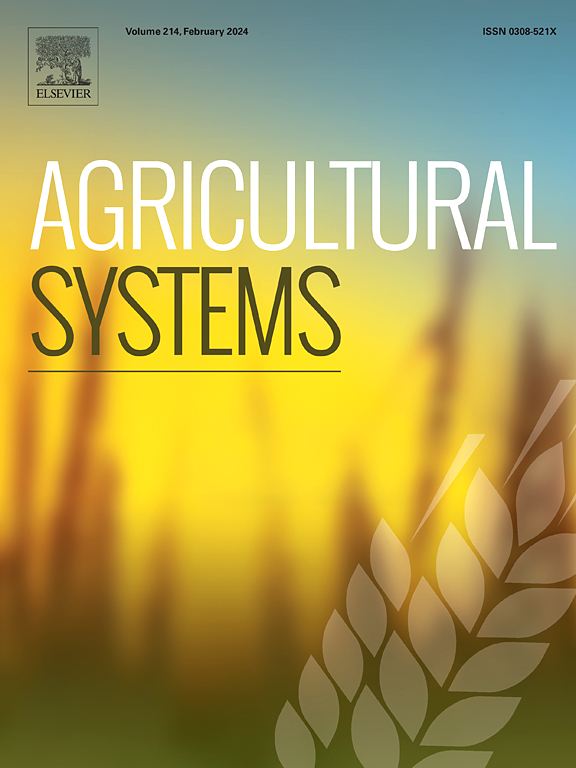在农艺土地利用模型中捕捉花带对自然虫害控制的影响
IF 6.1
1区 农林科学
Q1 AGRICULTURE, MULTIDISCIPLINARY
引用次数: 0
摘要
背景鉴于减少农药的政策目标,功能性生物多样性对农业生产越来越重要。然而,经济型土地利用优化模型很少考虑农业生产与功能性生物多样性(如天然害虫控制(NPC))之间的相互作用。这包括将基于半自然栖息地的通用氮磷钾模型与计量经济学方法联系起来,以估算作为氮磷钾潜力函数的产量差距。作为案例研究,该模型随后被应用于德国勃兰登堡州,以永久性花卉带为例,推广 NPC。结果和结论我们的分析表明,在勃兰登堡州无农药的环境中,通过花卉带提高氮磷钾水平最多可提高 6.4%的毛利率,作物产量最多可提高 1.2%。尽管该方法存在固有的局限性和不确定性,但我们的研究在将氮磷钾纳入经济土地利用模型方面取得了重要进展。在未来的改进中,如果能更详细地了解作物、害虫和捕食者之间特定环境下的相互作用,将能提高模型的稳健性。我们的方法和案例研究结果为制定量身定制的可持续景观发展政策提供了有价值的见解,并为未来的建模工作奠定了基础。纳入这些相互作用对于指导可持续农业系统政策至关重要。在这方面,开发和讨论进一步的方法论非常重要。本文章由计算机程序翻译,如有差异,请以英文原文为准。

Capturing the effects of flower strips on natural pest control in agronomic land use models
Context
Given policy objectives for pesticide reduction, functional biodiversity is increasingly important for agricultural production. However, economic land use optimisation models rarely account for the interplay between agricultural production and functional biodiversity, like natural pest control (NPC).
Objective
We present and discuss an approach to consider feedback effects between NPC and agricultural production in a geodata-based farm economic land use model.
Methods
The geodata-based land use model PALUD was extended to incorporate interactions between NPC and crop yields. This included linking a generic NPC model, based on semi-natural habitats, with an econometric approach to estimate yield gaps as a function of NPC potential. As a case study, the model was then applied to the German state Brandenburg, using permanent flower strips as example to promote NPC. Here, we analysed the impacts of enhancing NPC potential on food production and gross margins from arable land use.
Results and conclusions
Our analysis revealed that a higher level of NPC through flower strips improved gross margins. by up to 6.4 % and crop production by up to 1.2 % within a pesticide-free environment in Brandenburg. Despite inherent limitations and uncertainties of the approach, our study provides a pivotal advancement in integrating NPC into economic land use models. Future refinements incorporating more detailed knowledge on context-specific interactions between crops, pests and predators will improve model robustness. Our approach and case study results provide valuable insights for policy-making on tailored sustainable landscape development and serve as a foundation for future modelling efforts.
Significance
To our knowledge the interaction between NPC and crop yields has not yet been integrated into any geospatially based economic land use model before. Incorparating these interactions is vital for guiding policies towards sustainable agricultural systems. In this respect it is important to develop and discuss further methodological approaches.
求助全文
通过发布文献求助,成功后即可免费获取论文全文。
去求助
来源期刊

Agricultural Systems
农林科学-农业综合
CiteScore
13.30
自引率
7.60%
发文量
174
审稿时长
30 days
期刊介绍:
Agricultural Systems is an international journal that deals with interactions - among the components of agricultural systems, among hierarchical levels of agricultural systems, between agricultural and other land use systems, and between agricultural systems and their natural, social and economic environments.
The scope includes the development and application of systems analysis methodologies in the following areas:
Systems approaches in the sustainable intensification of agriculture; pathways for sustainable intensification; crop-livestock integration; farm-level resource allocation; quantification of benefits and trade-offs at farm to landscape levels; integrative, participatory and dynamic modelling approaches for qualitative and quantitative assessments of agricultural systems and decision making;
The interactions between agricultural and non-agricultural landscapes; the multiple services of agricultural systems; food security and the environment;
Global change and adaptation science; transformational adaptations as driven by changes in climate, policy, values and attitudes influencing the design of farming systems;
Development and application of farming systems design tools and methods for impact, scenario and case study analysis; managing the complexities of dynamic agricultural systems; innovation systems and multi stakeholder arrangements that support or promote change and (or) inform policy decisions.
 求助内容:
求助内容: 应助结果提醒方式:
应助结果提醒方式:


